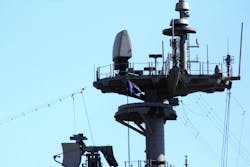Navy taps Leonardo DRS for common frequency generator components for shipboard missile-defense radar
MECHANICSBURG, Pa. – U.S. Navy surface warfare experts needed electronic components crucial to keeping missile-defense radar systems in sync. They found their solution from the Display, Processing, and Networking Center of Excellence of the Leonardo DRS Naval Electronics segment in Johnstown, Pa.
Officials of the Naval Supply Systems Command Weapon Systems Support Center in Mechanicsburg, Pa., announced a $7.5 million contract to Leonardo DRS earlier this month for common frequency generator assemblies for the AN/SPQ-9B radar set.
X-band radar
The AN/SPQ-9B is an X-band pulse-Doppler frequency-agile radar that scans out to the horizon and performs simultaneous and automatic air and surface target detection and tracking of low flying anti-ship cruise missiles, surface threats, low-and-slow-flying aircraft, unmanned aerial vehicles (UAVs), and helicopters.
A radar common frequency generator produces a precise stable RF signal as the primary radar carrier wave; it ensures that all radar components within a network operate on the same frequency for coordinated detection and tracking of targets. It helps synchronize the operating frequency across several radar units.
Related: Radar keeps a surveillance eye on the battlefield
A common frequency generator enables radar units in a network to measure the time it takes for a signal to travel to a target and back. For example, a radar common frequency generator helps air traffic control radars keep in sync across several radar stations to track aircraft positions accurately. This device also helps coordinate several military radar units in a complex network.
The AN/SPQ-9B missile-defense radar is designed for the littoral environment in harbors and along coastlines, rejects clutter, and has a low false track rate in the littorals and in other high-clutter environments. Its design makes the most of commercial off-the-shelf (COTS) and non-developmental item (NDI) equipment.
air-cooled cabinets
The unattended radar consists of four air-cooled below-deck cabinets, a motor generator, and one above-deck antenna unit designed for low-radar-cross-section reflectivity appropriate for stealth ship design.
The AN/SPQ-9B is for aircraft carriers, amphibious assault ships, cruisers, Coast Guard maritime security cutters, Arleigh Burke-class destroyers, and allied cruisers and destroyers.
Related: Putting the squeeze on RF and microwave gear
Above decks, the radar uses a mechanically rotating, electronically stabilized antenna. The 1,500-pound antenna consists of dual planar arrays mounted back-to-back, each connected to independent transmitters and receivers. Below decks, the radar consists of processor, receiver/exciter, and transmitter cabinets; radar set control; and motor generator.
Signal processing
The processor cabinet performs signal processing, tracking, and interface functions. The receiver/exciter has three receivers, and generates system frequencies and clocks. The transmitter cabinet receives the RF pulses from the receiver/exciter and amplifies them for output to the antenna.
The radar set control provides remote control and monitoring of radar operation in the ship's combat information center. The output of each receiver is converted to digital baseband I-Q data for Doppler processing in the processor cabinet. The system has an auxiliary antenna for electronic counter-countermeasures.
Related: Overcoming the MIMO ADC channel synchronization challenge
The AN/SPQ-9B radar has digital interfaces to the Aegis combat systems, the MK 34 gun weapon system (GWS), the MK 48 GWS, the Cooperative Engagement Capability, and ship self defense system.
Leonardo DRS Naval Electronics won a $66.2 million Navy order last month for AN/SPQ-9B shipboard anti-ship missile defense (ASMD) radar systems to help protect U.S. Navy surface warships from enemy anti-ship missiles.
On the common frequency generator contract, Leonardo DRS will do the work in Johnstown, Pa., and should be finished by December 2027. For more information contact the Leonardo DRS Naval Electronics Display, Processing, and Networking Center of Excellence online at www.leonardodrs.com/locations/naval-electronics-laurel-technologies-johnstown-pa, or the Naval Supply Systems Command Weapon Systems Support Center-Mechanicsburg at https://www.navsup.navy.mil/NAVSUP-Enterprise/NAVSUP-Weapon-Systems-Support/Welcome-Mechanicsburg/.
About the Author
John Keller
Editor-in-Chief
John Keller is the Editor-in-Chief, Military & Aerospace Electronics Magazine--provides extensive coverage and analysis of enabling electronics and optoelectronic technologies in military, space and commercial aviation applications. John has been a member of the Military & Aerospace Electronics staff since 1989 and chief editor since 1995.
